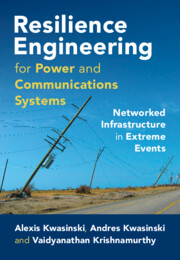 Resilience Engineering for Power and Communications Systems
Resilience Engineering for Power and Communications Systems Published online by Cambridge University Press: 04 January 2024
This chapter explains problems associated with planning infrastructure systems in order to improve resilience. Understanding the concept and basic methods for planning infrastructure investments is an important aspect for studying resilience because planning is a key process that contributes to resilience preparedness and adaptation attributes. Initially, the chapter discusses the fundamental problems and issues found when making decisions about investment allocations amid uncertain conditions. Then, probabilistic risk assessment (PRA) as still the main tool used in industry in planning processes is explained. Because characterizing intensity and other relevant attributes of disruptive events is an important component of planning processes for enhancing resilience, this chapter continues by exploring how these events – and especially hurricanes – can be characterized in order to obtain information that can be used as input for the planning process. Finally, the chapter concludes by discussing economic concepts and tools related to infrastructure resilience enhancement planning processes.
To save this book to your Kindle, first ensure [email protected] is added to your Approved Personal Document E-mail List under your Personal Document Settings on the Manage Your Content and Devices page of your Amazon account. Then enter the ‘name’ part of your Kindle email address below. Find out more about saving to your Kindle.
Note you can select to save to either the @free.kindle.com or @kindle.com variations. ‘@free.kindle.com’ emails are free but can only be saved to your device when it is connected to wi-fi. ‘@kindle.com’ emails can be delivered even when you are not connected to wi-fi, but note that service fees apply.
Find out more about the Kindle Personal Document Service.
To save content items to your account, please confirm that you agree to abide by our usage policies. If this is the first time you use this feature, you will be asked to authorise Cambridge Core to connect with your account. Find out more about saving content to Dropbox.
To save content items to your account, please confirm that you agree to abide by our usage policies. If this is the first time you use this feature, you will be asked to authorise Cambridge Core to connect with your account. Find out more about saving content to Google Drive.